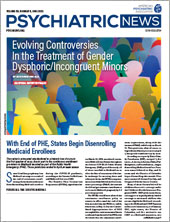One of the more highly publicized policies was initiated in New York City, where Mayor Eric Adams lowered the threshold that first responders should use to consider before involuntarily transporting a person with mental illness experiencing homelessness to a hospital (“
M.D.s Call for Community Resources Amid Plans to Force Homeless Into Care”). Similar actions are being considered in Portland, Ore. In California,
legislation was passed that creates a special court through which people with serious mental illness can be compelled into treatment. Finally, a
$1 billion plan in New York was announced in February that would boost inpatient psychiatric treatment capacity as well as outpatient services.
Two recent articles published in JAMA Psychiatry investigate the New York City mayor’s new policy. Another, published in JAMA, highlights the unmet need for medium- or long-term inpatient care for some patients, and proposes principles that new, facility-based care models should consider.
“People experiencing homelessness and mental illness have suffered for centuries,” Katherine Koh, M.D., M.Sc., a psychiatrist at the Boston Health Care for the Homeless Program and Massachusetts General Hospital, and her colleague wrote in their JAMA article. “If health care professionals, patient advocates, and policy makers seize the moment and fight for investment in innovative and evidence-informed strategies, we may witness the dawn of a new era.”
‘Here We Go Again,’ Former MH Commissioner Cautions
In November, Adams
issued a directive to first responders, including police officers, paramedics, and outreach workers,
instructing them to involuntarily transport individuals with mental illness who are experiencing homelessness to hospitals if they present a serious risk of harm to themselves or others. In addition to expanding the use of involuntary transportation to hospitals, Adams’ directive also lowers the threshold of what is considered harm, instructing authorities to remove an individual from the streets or subway if he or she appears unable to “meet basic living needs, even when no recent dangerous acts have been observed.” Further, Adams outlined an 11-point
legislative agenda that includes his top priorities to address at the state level and would add many of the initiatives included in his directive to the state code.
“One might say, here we go again,” wrote Michael Hogan, Ph.D., in his
JAMA Psychiatry viewpoint. Hogan served as New York state Commissioner of Mental Health from 2007 to 2012, director of the Ohio Department of Mental Health from 1991 to 2007, and commissioner of the Connecticut Department of Mental Health from 1987 to 1991. He chaired President George W. Bush’s New Freedom Commission on Mental Health from 2002 to 2003.
Hogan pointed out that past policies have similarly attempted to address the problem of people with mental illness experiencing homelessness, but the cycle continues.
Further, Adams’ policy pushes against current trends, Hogan wrote. The policy increases police intervention while significant work is being done in other areas to decriminalize people with mental illness, such as the implementation of the 988 National Suicide Prevention Lifeline. Additionally, he noted, there are benefits and drawbacks to increased hospitalization. While inpatient treatment will likely reduce symptoms for people with acute illness, involuntary hospitalization initiated by police can be traumatic and intrusive.
“A more substantial limitation of the proposal is the fact that access to ‘aftercare,’ principally stable housing and flexible treatment and support, is not ensured in the mayor’s plan,” Hogan wrote. “Without these, any value achieved through hospitalization is temporary, providing only time-limited clinical benefit.” A more effective approach is to provide access to housing—particularly permanent supported housing (which Hogan called “the gold standard for addressing homelessness”)—as well as continued, clinically competent, and engaging treatment.
‘A Violation of Human Rights’
In another
JAMA Psychiatry viewpoint, Nick Kerman, Ph.D., a project scientist with the Centre for Addiction and Mental Health in Toronto, and colleagues wrote that Adams’ policy is an example of those policies that, in the absence of government investment, “lead people with mental illness experiencing homelessness to be moved ‘out of sight, out of mind.’”
“We believe that New York City’s policy approach is a violation of human rights, harms the personhood of people with mental illness experiencing homelessness, and that this policy will have deleterious effects on this population, mental health services, and evidence-based interventions for homelessness,” the authors continued.
Involuntary hospitalization in the absence of imminent risk threatens to further erode this population’s “self-determination in seeking health care and service engagement” and “heightens the power imbalance between people experiencing homelessness and those providing them with services,” they wrote. They point to several other negative impacts of the policy, including the following:
•
It perpetuates structural stigma in assuming people with mental illness experiencing homelessness cannot care for themselves and need to be hospitalized for theirs and others’ safety.
•
It overlooks why people with mental illness are living on the streets and not in shelters and does not address their concerns about safety in emergency shelters.
•
It burdens mental health systems that become tasked with addressing the housing and shelter needs of those admitted to the hospital.
“Involuntary hospitalization and outpatient care, with appropriate safeguards and practices to ensure procedural justice, have an important role in mental health systems,” Kerman and colleagues concluded. “However, the New York City policy oversteps these important boundaries and is not the answer to homelessness among individuals with serious mental illness. Instead, it is the latest form of displacement-based approaches to unsheltered homelessness.”
Legal action has been taken in response to the mayor’s directive. In December, several individuals and advocacy groups requested a judge stop the directive immediately. But in February, a U.S. District Judge in the Southern District of New York denied the plaintiffs’ motion, allowing the directive to continue,
CNN reported.
More recently, the New York Civil Liberties Union (NYCLU)
filed a lawsuit against the New York Police Department (NYPD). The lawsuit claims the NYPD did not comply with a Freedom of Information Act request submitted by NYCLU that sought more information on the policies, procedures, and trainings associated with the mayor’s directive.
“Given the importance of the [d]irective, the high amount of public and media attention it has garnered, and the central role the NYPD plays in implementing the Mayor’s new involuntary removal standard, it is unacceptable for the NYPD to conceal information regarding its role in the implementation of the Involuntary Removals Directive from the public,” states the
lawsuit, which was filed March 17.
Bedrock of Care Continuum Must Be Homelessness Prevention, Authors Argue
In their
JAMA viewpoint, Koh and her colleague
argued that the various proposals recently made by mayors and governors across the country “provides an urgent opportunity to implement community-based care options, reimagine institutionalization, and finally build a functional continuum of care for those experiencing homelessness and mental illness.”
Funds to create a supportive and autonomy-promoting system of care are vital, the authors wrote. “The bedrock of this system must be homelessness prevention.” Such strategies include increasing access to community-based services and stable housing.
There are, additionally, some cases when patients require long-term, inpatient care. Yet since the deinstitutionalization movement, there are far fewer publicly accessible, effective options than are necessary, they wrote. “We therefore support a limited rebuilding of public facility-based care capacity for people with severe mental illness, ideologically distinct from institutions of the past,” they wrote. They outlined three principles that should guide the creation of new care models:
•
Care must be provided in spaces that provide purpose, encourage meaningful relationships, and provide nourishing environments. “Institutions modeled after traditional prisons and hospital, which optimize safety by prioritizing isolation and oversight over community building, risk attacking mental illness while neglecting mental health,” they wrote.
•
Facility leaders must carefully create cultures that encourage compassion, follow trauma-informed principles, and avoid the dehumanizing cultures of asylums.
•
Facilities must have established, collaborative relationships with community care programs, and ensure patients do not have to coordinate their own care without support.
“Recent political momentum presents an opportunity to finally provide dignity, support, and humane care to those experiencing homelessness and mental illness,” Koh concluded. “Informed by historical missteps, leaders should recognize that a continuum of preventive, community, and facility-based services is essential.” ■



